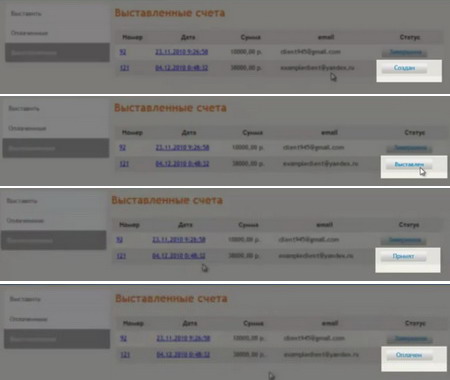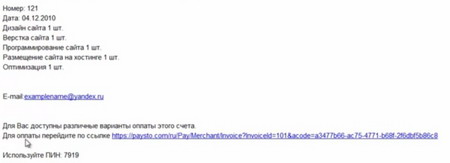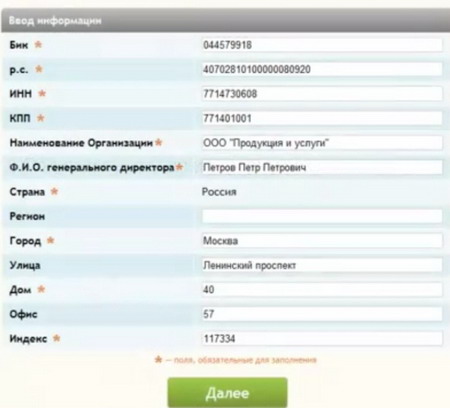Implementing and receiving payment in linkCharge
Last time I brought to your attention a review of the invoice creation service linkCharge , the most convenient product from PaySto for freelancers. With its help, remote employees can create accounts for customers, receive payment and withdraw it, turning it into cash.
This time I will review the details of the work of linkCharge, namely, how the account is created and sent, how its status changes during the payment process, how the customer works with the account, who pays the fee, and finally, how funds are withdrawn from PaySto.
Each user of the system has his own account, "Personal Account". In it, accounts are created and the process of their payment is monitored. In the process of invoicing the user must follow all the instructions specified in the system. Thus, the described types of services should correspond to the types of activities specified by the system (these are services in the field of advertising, software, design, printing or information). The amount of payment should not exceed or be below the limits of the system (they can be found during the work with PaySto). Finally, the service invoiced for payment must be provided to the customer within 5 calendar days.
I already considered the details of creating an account in a previous post , but now I want to draw attention to the control over the process of receiving a fee. Once an account is created and verified by PaySto employees, it receives the status of the created account. By the way, each status can be checked simply by updating the page with the list of accounts. After being sent to the customer, it is marked as issued, and as soon as the customer becomes acquainted with its content and confirms its acceptance of payment, the status of the invoice changes to “Accepted”. After paying the fee, it becomes “Paid”.
')

In order for the funds to get to the account of the user-executor of the service in the PaySto system, the customer must sign the certificate of completion and thereby confirm receipt of the service. As a result, money is transferred to the account of the contractor, and the account is designated as “Completed”.
In the case of a customer, he receives a letter generated by the linkCharge system to his e-mail address. It contains information about the work performed, a description and a list of services, and a link to the invoice for payment. The letter indicates the pin code for entry on the site linkCharge, which will give the customer access to this account.

When viewing and confirming an invoice, the customer chooses a payment method (bank or money transfer, or payment using electronic money).

To transfer funds to the PaySto system, and then to the contractor’s account, the customer fills out a payer form in the linkCharge system, where all necessary details such as his bank account number, individual taxpayer number, organization name, etc. are entered.

The contract and the necessary applications in PDF format are attached to the invoice, which the customer prints, signs and sends to the contractor at the address specified in the contract. When the receipt of services is confirmed by the corresponding certified act, and the payment is already in the PaySto system, the money is transferred to the account of the contractor.
Then, the performer who received his fee can simply withdraw funds from the system and cash them. To do this, in his "Personal Account", he looks at the balance and selects the option "Pick up" money. The linkCharge system indicates the number of the bank account to which funds are to be received. Upon confirmation of the transaction, the specified amount is sent from the system to the user's account.

The process of sending funds from the system to the account will take some time, during which the status of the payment will vary depending on the stage of the payment. When money is withdrawn from an account with PaySto, it means that they have already been transferred to an account in a bank owned by the executor.
A fee in favor of linkCharge for services provided by a startup is charged during the implementation of transactions. The system indicates the deductible interest, which depends on the amount of funds transferred.
This time I will review the details of the work of linkCharge, namely, how the account is created and sent, how its status changes during the payment process, how the customer works with the account, who pays the fee, and finally, how funds are withdrawn from PaySto.
Each user of the system has his own account, "Personal Account". In it, accounts are created and the process of their payment is monitored. In the process of invoicing the user must follow all the instructions specified in the system. Thus, the described types of services should correspond to the types of activities specified by the system (these are services in the field of advertising, software, design, printing or information). The amount of payment should not exceed or be below the limits of the system (they can be found during the work with PaySto). Finally, the service invoiced for payment must be provided to the customer within 5 calendar days.
I already considered the details of creating an account in a previous post , but now I want to draw attention to the control over the process of receiving a fee. Once an account is created and verified by PaySto employees, it receives the status of the created account. By the way, each status can be checked simply by updating the page with the list of accounts. After being sent to the customer, it is marked as issued, and as soon as the customer becomes acquainted with its content and confirms its acceptance of payment, the status of the invoice changes to “Accepted”. After paying the fee, it becomes “Paid”.
')

In order for the funds to get to the account of the user-executor of the service in the PaySto system, the customer must sign the certificate of completion and thereby confirm receipt of the service. As a result, money is transferred to the account of the contractor, and the account is designated as “Completed”.
In the case of a customer, he receives a letter generated by the linkCharge system to his e-mail address. It contains information about the work performed, a description and a list of services, and a link to the invoice for payment. The letter indicates the pin code for entry on the site linkCharge, which will give the customer access to this account.

When viewing and confirming an invoice, the customer chooses a payment method (bank or money transfer, or payment using electronic money).

To transfer funds to the PaySto system, and then to the contractor’s account, the customer fills out a payer form in the linkCharge system, where all necessary details such as his bank account number, individual taxpayer number, organization name, etc. are entered.

The contract and the necessary applications in PDF format are attached to the invoice, which the customer prints, signs and sends to the contractor at the address specified in the contract. When the receipt of services is confirmed by the corresponding certified act, and the payment is already in the PaySto system, the money is transferred to the account of the contractor.
Then, the performer who received his fee can simply withdraw funds from the system and cash them. To do this, in his "Personal Account", he looks at the balance and selects the option "Pick up" money. The linkCharge system indicates the number of the bank account to which funds are to be received. Upon confirmation of the transaction, the specified amount is sent from the system to the user's account.

The process of sending funds from the system to the account will take some time, during which the status of the payment will vary depending on the stage of the payment. When money is withdrawn from an account with PaySto, it means that they have already been transferred to an account in a bank owned by the executor.
A fee in favor of linkCharge for services provided by a startup is charged during the implementation of transactions. The system indicates the deductible interest, which depends on the amount of funds transferred.
Source: https://habr.com/ru/post/132707/
All Articles